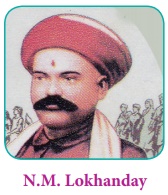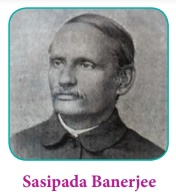Rise of Labour Movement
Introduction of machinery, new methodsofproduction, concentration of factories in certain big cities gave birth to a new class of wage earners called factory workers. In India, the factory workers, mostly drawn from villages, initially remained submissive and unorganised. Many leaders like Sorabjee Shapoorji and N.M. Lokhanday of Bombay and Sasipada Banerjee of Bengal raised their voice for protecting the interests of the industrial labourers.

In the aftermath of Swadeshi Movement (1905) Indian industries began to thrive. During the War the British encouraged Indian industries which manufactured war time goods. As the war progressed they wanted more goods so more workers were recruited. Once the war ended workers were laid off and production cut down. Further prices increased dramatically in the post-War situation. India was also in the grip of a world-wide epidemic of influenza. In response labourers began to organize to fight and trade unions were formed to protect the interests of the workers.
The success of the Bolshevik Revolution of 1917 also had its effect on Indian labour. A wave of ideas of class consciousness and enlightenment swept the world of Indian labours. The Indian soldiers who had fought in Europe brought the news of good labour conditions. The industrial unrest that grew up as a result of grave economic difficulties created by War, and the widening gulf between the employers and the employees, and the establishment of International Labour Organisation of the League of Nations brought mass awakening among the labours.
Madras played a pivotal role in the history of labour movement of India. The first trade union in the modern sense, the Madras Labour Union, was formed in 1918 by B.P. Wadia. The union was formed mainly due to the ill-treatment of Indianworker in the Buckingham and Carnatic Mills, Perambur. Theworking conditions was poor. Short interval for mid-day meal, frequent assaults on workers by the European assistants and inadequate wages led to the formation of this union. This union adopted collective bargaining and used trade unionism as a weapon for class struggle.

This wave spread to other parts of India and many unions were formed at this time such as the Indian Seamen’s Union both at Calcutta and Bombay, the Punjab Press Employers Association, the G.I.P. Railway Workers Union Bombay, M.S.M. Railwaymen’s Union, Union of the Postmen and Port Trust Employees Union at Bombay and Calcutta, the Jamshedpur Labour Association, the Indian Colliery Employees Association of Jharia and the Unions of employees of various railways. To suppress the labour movement the Government, with the help of the capitalists, tried by all means to subdue the labourers. They imprisoned strikers, burnt their houses, and fined the unions, but the labourers were determined in their demands.
Nationalist leaders and intellectuals were moved by the plight of the workers, and many of them worked towards organizing them into unions. Their involvement also led to the politicization of the working class, and added to the strength of the freedom movement as most of the mills were owned by Europeans who were supported by the government.
On 30 October 1920, representatives of 64 trade unions, with a membership of 140,854, met in Bombay and established the All India Trade Union Congress (AITUC) under the Chairmanship of Lala Lajpat Rai. It was supported by national leaders like Motilal Nehru, Jawaharlal Nehru, C.R. Das, Vallabhbhai Patel, Subhash Chandra Bose and others from the Indian National Congress.
The trade unions slowly involved themselves in the national movement. In April 1919 after the Jallianwala Bagh Massacre and Gandhi’s arrest, the working class in Ahmedabad and other parts of Gujarat resorted to strikes, agitations and demonstrations. Trade unions were not recognised by the capitalists or the government in the beginning. But the unity of the workers and the strength of their movement forced the both to recognise them. From 1919–20 the number of registered trade unions increased from 107 to 1833 in 1946–47.














